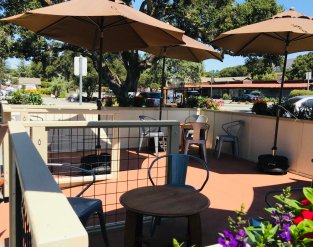I wasn’t planning to post again so soon about another Parsonage wine, but I couldn’t pass up the opportunity to highlight this library wine as my 400th COVID wine (of all wines tasted during COVID per my broader Facebook blog – se reference below)! 400!!! We were so lucky to get this 2006 Parsonage Carmelstone Syrah in our recent allocation (thank you, Summer). I told my husband that we must open this with the COVID Wine Pod for a special occasion. Just before the 4th of July, a mutual friend of ours came to town – the man who let us know in the first place that the Dubee’s had moved to our little coastal town, much less to our street! Small world.
We debated whether to decant this library wine. In the end, we decided to decant it right before drinking – that seemed to work! This wine compared equally in quality and taste to a 96-point rated Napa Cabernet Sauvignon we also tasted that night! Watch out, Napa! Here comes Carmel Valley! So I have switched up the lineup, making this extremely special wine my 400th wine!

Today’s Parsonage Rocco Syrah is my favorite wine – but we used to get a wine labeled “Carmelstone.” When I asked Bill Parsons for more information about the wine over the weekend, he sent it back to me within hours! He shared the following:
“The Carmelstone Reserve is 100% Estate Syrah from the upper northeast corner block of our vineyard, maybe one and a quarter acre. The soil is clay-loam-silt with a generous lacing of fragmented chalk rock, what we call carmelstone. The slope, or as I like to say “angle of repose,” is 15-20 %.
“I think we last produced the Carmelstone in 2009. Sparse yields from 2010 to the present have forced us to eliminate its production. We thought of the Carmelstone as Rocco junior. It had a unique character that made Frank and me want to produce it instead of folding it into the Rocco and Estate Syrah bottlings. Now we get so little yield from that block that we put its fruit in the Estate.
“The low yield from that block has to do with drought, extreme heat cycles, pestilence, inadequate irrigation water, all of our personal horsemen of the apocalypse. Smoke taint, my least favorite horseman doesn’t enter into it.”
2006 Parsonage Carmelstone Reserve Syrah, Carmel Valley, 15% ABV, $125 (#400*)

Winery Notes: “The 2006 vintage is considered one of our greatest of the first decade of the new millennium along with the ‘01, 03, and ‘08 vintages. It is/was exceptional in my view. You confirm my view by relating the Carmelstone to a six year younger Napa cult cabernet that sold for maybe three to four times the price of our $60 bottle.” (FYI from Sharon: )
My Review: Beautiful dark ruby in the glass. Smooth, rich dark berries. I jumped at the chance to get this Carmelstone – one of my favorites made by Parsonage and this library vintage was very good, exceptional. The 2006 compared very favorably to a younger, high-end, 96-point Napa Cab we tasted immediately following. I’ve seen the 2005 vintage rated 96 points! June 2021

Tasting Room Photo Courtesy Parsonage 
Parsonage is open for tastings by reservation every day – click here for the details. You can obtain their wines directly from the winery here or at their tasting room located at 19 E Carmel Valley Road in Carmel Valley Village.
*Refers to wines tasted while Sheltering in Place on Sharon’s personal Facebook group “Sharon’s Central Coast (Monterey) Wine Blog” – including non-Central Coast wines.














































Recent Comments